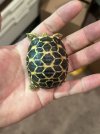rachelraines
Member
Hi guys!! I’m getting my four month old Burmese star tomorrow!! I have been testing out the enclosure today checking humidity and temperature ranges. This may sound like a silly question but I want to prevent pyramiding as much as possibly- I know humidity, temperature, and diet has a lot to do with it. In terms of diet, I know that their protein intake should be minimal but what is considered protein for a tortoise? Also, would you guys recommend leaving the UVB light on all times and turning on the basking one at night? Vise versa? Turning them both off? Leaving them both on? I’m so nervous and want to make sure I’m doing everything correctly. I will be keeping it in my heated sunroom ensuring the room itself stays very warm. I have a closed shallow enclosure for now and I’m going to get some live plants to help with humidity. Do you guys have any suggestions on plants you guys like? How do you treat them before putting them in the enclosure with your tort? Sorry this is a lot of rambling and questions but like I said - new mom here! 



